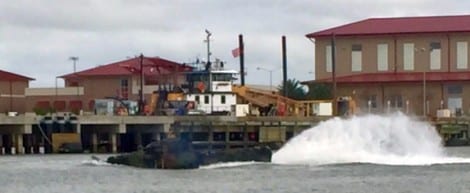 By Bob Currie, Recreational Boating Safety Specialist
By Bob Currie, Recreational Boating Safety Specialist
U. S. Coast Guard Auxiliary Station Galveston Flotilla
The Coast Guard makes urgency, safety and scheduled marine information broadcasts using various radio frequencies. The broadcasts include information vital to maritime interests in the vicinity of all U.S. waters (including the Caribbean). I strongly advocate that recreational boaters carry and use a marine VHF/FM radio because they will miss these important broadcasts if they don’t. The Coast Guard broadcasts three types of safety messages. They are Urgency Messages, Safety Messages, and Scheduled Messages.
The Station Galveston Flotilla of the US Coast Guard Auxiliary operates out of the USCG Station Galveston base on Galveston Island. They aid the Coast Guard by providing maritime observation patrols in Galveston Bay; by providing recreational boating vessel safety checks; and by working alongside Coast Guard members in maritime accident investigation, small boat training, Aids to Navigation verification, and watch standing.
Urgency Messages (PAN-PAN)
Urgency broadcasts are transmitted on Channel 16 (156.8 MHz) plus, if required, the district working frequency. Such broadcasts are preceded by the Urgency Signal, PAN-PAN (repeated three times; pronounced pawn-pawn). The Coast Guard broadcasts urgent information upon receipt, repeats it 15 minutes later, and repeats it during scheduled broadcasts. These messages are relative to the safety of ships, aircraft, persons, etc.
Safety Messages (SECURITE)
Safety broadcasts are transmitted on Channel 22A (157.1 MHz). Such broadcasts are preceded by the Safety Signal, SECURITE (repeated three times; pronounced say-coo-ree-tay). The times of the broadcast are the same as for the Urgency broadcasts. These messages are relative to the safety of navigation or are important meteorological warnings. The call announcing the broadcast is made on the calling channels in the area concerned. In our area, where all vessels are required to monitor Channel 16, the Coast Guard Watchstander will announce “SECURITE, SECURITE, SECURITE. Attention all mariners: for an important marine information bulletin please go to Channel 22 Alpha.” The Watchstander will then switch to Channel 22A, repeat the Safety Signal, and then broadcast the information.
A good example of the need for a SECURITE safety message was this weekend when the Marines were conducting an exercise in the Galveston Channel with their Assault Amphibious Vehicles (AAVP-7A1). The AAVP-7A1 is a fully tracked amphibious armored personnel carrier. It has been used in the Falklands War, Invasion of Grenada, Persian Gulf War, Somali Civil War, and Iraq War. Our job was to provide a safety zone for the three AAVPs used in the exercise while they practice launching, maneuvering, and recovering in the Galveston Channel between the Coast Guard Station and the ferry landing. The Watchstander’s job was to notify the local marine traffic about the exercise using a safety message. It was the responsibility of the mariners to then avoid the area.
Although commercial vessels are required to have marine VHF/FM radios and to monitor Channel 16, recreational boaters have no such requirements. However, these vessels were very hard to see in the water, and we could definitely tell which boats didn’t have marine radios. They operated oblivious to the warning to avoid the area where we were operating. That is why recreational boats that operate in areas where there is commercial traffic need marine radios.

Scheduled Broadcasts
The scheduled marine information broadcasts are transmitted on Channel 22A (157.1 MHz). These messages are relative to important notices to mariners, oceanographic information, storm warnings, and all urgent and safety broadcasts in which the information has remained unchanged (Urgency and Safety signals are not re-broadcast in the latter case). The times of the broadcast are different among the various districts.
Vessel Traffic Service Houston/Galveston
Vessel Traffic Service Houston/Galveston’s mission is to facilitate safe, efficient waterborne commerce. Specifically, VTS Houston/Galveston exists to prevent groundings, allisions, and collisions by sharing information and implementing appropriate traffic management measures. VTS Houston/Galveston also provides safety messages. As with the Coast Guard, they announce their intention to broadcast a safety message, but they instruct mariners to go to Channel 5A instead of Channel 22A, which is reserved for the Coast Guard.
Summary
If you do not have a VHF/FM marine radio, or if you have one and do not monitor Channel 16 for Urgency and Safety Alerts, you may be putting yourself and your passengers unnecessarily in danger. Even a 5-watt handheld radio will do the trick. They can be purchased for less than $100. The radio is not just for transmitting emergencies to the Coast Guard. It is more often used to help you keep abreast of critical marine information.
For more information on boating safety, please visit the Official Website of the U.S. Coast Guard’s Boating Safety Division at www.uscgboating.org. Questions about the US Coast Guard Auxiliary or our free Vessel Safety Check program may be directed to me at [email protected]. I am available to perform free Vessel Safety Checks, and I will come to your location to perform them. SAFE BOATING!
[1-13-2020]

 Posted in
Posted in 
























